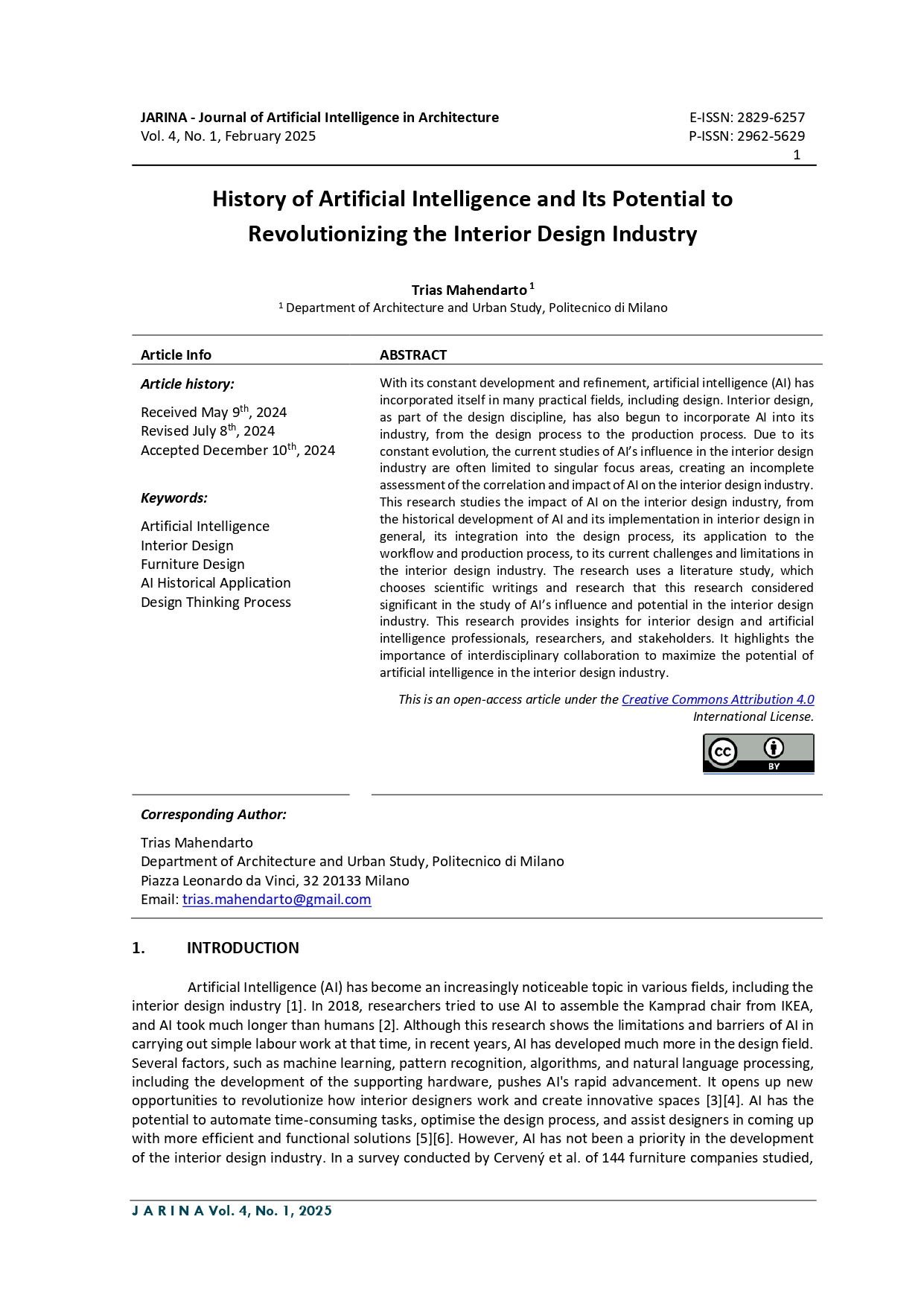History of Artificial Intelligence and Its Potential to Revolutionising the Interior Design Industry
DOI:
https://doi.org/10.24002/jarina.v4i1.9111Keywords:
Artificial Intelligence, Interior Design, Furniture Design , AI Historical Application, Design Thinking ProcessAbstract
With its constant development and refinement, artificial intelligence (AI) has incorporated itself in many practical fields, including design. Interior design, as part of the design discipline, has also begun to incorporate AI into its industry, from the design process to the production process. Due to its constant evolution, the current studies of AI’s influence in the interior design industry are often limited to singular focus areas, creating an incomplete assessment of the correlation and impact of AI on the interior design industry. This research studies the impact of AI on the interior design industry, from the historical development of AI and its implementation in interior design in general, its integration into the design process, its application to the workflow and production process, to its current challenges and limitations in the interior design industry. The research uses a literature study, which chooses scientific writings and research that this research considered significant in the study of AI’s influence and potential in the interior design industry. This research provides insights for interior design and artificial intelligence professionals, researchers, and stakeholders. It highlights the importance of interdisciplinary collaboration to maximize the potential of artificial intelligence in the interior design industry.
References
[1] O. Kontovourkis and G. Tryfonos, “Integrating parametric design with robotic additive manufacturing for 3D clay printing: An experimental study,” ISARC 2018 - 35th Int. Symp. Autom. Robot. Constr. Int. AEC/FM Hackathon Futur. Build. Things, no. Isarc, 2018, doi: 10.22260/isarc2018/0128.
[2] “The Kamprad test: IKEA furniture and the limits of AI,” Econ. (United Kingdom), vol. 414, no. 9085, 2018.
[3] R. Girling, “AI and the Future of Design: What will the designer of 2025 look like?,” artefact group, 2018. https://www.artefactgroup.com/ideas/ai_design_2025/ (accessed Apr. 15, 2024).
[4] T. Wortmann and B. Tunçer, “Differentiating parametric design: Digital workflows in contemporary architecture and construction,” Des. Stud., vol. 52, pp. 173–197, 2017.
[5] L. Villaggi, “Generative Design for Architectural Space Planning: The Case of the Autodesk,” 2017, [Online]. Available: http://lorenzovillaggi.com/http://danilnagy.com/
[6] S. Boeykens, “Using 3D design software, BIM and game engines for architectural historical reconstruction,” Des. Together CAADFutures 2011 - Proc. 14th Int. Conf. Comput. Aided Archit. Des., pp. 493–509, 2011.
[7] L. Červený, R. Sloup, T. Červená, M. Riedl, and P. Palátová, “Industry 4.0 as an Opportunity and Challenge for the Furniture Industry—A Case Study,” Sustain., vol. 14, no. 20, 2022, doi: 10.3390/su142013325.
[8] G. Stiny, “Introduction to shape grammars,” Environ. Plan. B Plan. Des., vol. 7, no. 3, pp. 343–351, 1980, doi: 10.1145/1401132.1401182.
[9] R. Oxman, “Thinking difference: Theories and models of parametric design thinking,” Des. Stud., vol. 52, pp. 4–39, 2017, doi: 10.1016/j.destud.2017.06.001.
[10] R. T. Ogawa and B. Malen, “Towards Rigor in Reviews of Multivocal Literatures: Applying the Exploratory Case Study Method,” Rev. Educ. Res., vol. 61, no. 3, pp. 265–286, 1991, doi: 10.3102/00346543061003265.
[11] A. M. Turing, “Computing machinery and intelligence,” Mind, a quarterly Rev. Psychol. Philos., vol. LIX, no. 236, pp. 433–460, 1950.
[12] J. McCarthy, M. L. Minsky, N. Rochester, and C. E. Shannon, “A proposal for the Dartmouth summer research project on artificial intelligence,” AI Mag., vol. 27, no. 4, pp. 12–14, 2006.
[13] S. Russell and P. Norvig, Artificial Intelligence: A Modern Approach, 2nd ed. New Jersey: Pearson Education, Inc., 2003.
[14] N. Leach, Architecture in the Age of Artificial Intelligence: An introduction to AI for architects, no. September 2016. London: Bloomsbury Visual Arts, 2022.
[15] S. Chaillou, AI and architecture: An experimental perspective, 1st ed. Routledge, 2021.
[16] H. Bier and T. Knight, “Digitally-Driven architecture,” Footprint, no. 6, pp. 1–4, 2010, doi: 10.59490/footprint.4.1.715.
[17] R. Wolniak, “The Design Thinking Method And Its Stages,” Syst. Wspomagania W Inżynierii Prod., vol. 6, no. 6, pp. 247–255, 2017.
[18] R. Verganti, L. Vendraminelli, and M. Iansiti, “Innovation and Design in the Age of Artificial Intelligence,” J. Prod. Innov. Manag., vol. 37, no. 3, pp. 212–227, 2020, doi: 10.1111/jpim.12523.
[19] R. Brisco, L. Hay, and S. Dhami, “Exploring the Role of Text-To-Image AI in Concept Generation,” Proc. Des. Soc., vol. 3, no. JULY, pp. 1835–1844, 2023, doi: 10.1017/pds.2023.184.
[20] S. Krish, “A practical generative design method,” CAD Comput. Aided Des., vol. 43, no. 1, pp. 88–100, 2011, doi: 10.1016/j.cad.2010.09.009.
[21] D. Van Daele, N. Decleyre, H. Dubois, and W. Meert, “An Automated Engineering Assistant: Learning Parsers for Technical Drawings,” 35th AAAI Conf. Artif. Intell. AAAI 2021, vol. 17B, pp. 15195–15203, 2021, doi: 10.1609/aaai.v35i17.17783.
[22] B. Bölek, M. Ali Altın, and H. Özbaşaran, “Interior Design with Metaheuristics: A Prototype Application,” pp. 231–240, 2023, [Online]. Available: https://www.researchgate.net/publication/376414692
[23] W. Huang and H. Zheng, “Architectural drawings recognition and generation through machine learning,” Recalibration Imprecision Infidelity - Proc. 38th Annu. Conf. Assoc. Comput. Aided Des. Archit. ACADIA 2018, pp. 156–165, 2018, doi: 10.52842/conf.acadia.2018.156.
[24] Y. Hou, M. Yang, H. Cui, L. Wang, J. Xu, and W. Zeng, “C2Ideas: Supporting Creative Interior Color Design Ideation with Large Language Model,” pp. 1–26, 2024, doi: 10.1145/3613904.3642224.
[25] D. Milne, L. Davison, and L. Ausiello, “Use of artificial intelligence in room acoustics prediction using a photograph,” Proc. Inst. Acoust., vol. 42, 2020, doi: 10.25144/13372.
[26] T. Paterson, “AI in the Lighting Space,” IES - The Lighting Authority, 2023. https://www.ies.org/lda/ai-in-the-lighting-space-2/ (accessed Apr. 23, 2024).
[27] M. U. Mehmood, D. Chun, Zeeshan, H. Han, G. Jeon, and K. Chen, “A review of the applications of artificial intelligence and big data to buildings for energy-efficiency and a comfortable indoor living environment,” Energy Build., vol. 202, p. 109383, 2019, doi: 10.1016/j.enbuild.2019.109383.
[28] H. Farzaneh, L. Malehmirchegini, A. Bejan, T. Afolabi, A. Mulumba, and P. P. Daka, “Artificial intelligence evolution in smart buildings for energy efficiency,” Appl. Sci., vol. 11, no. 2, pp. 1–26, 2021, doi: 10.3390/app11020763.
[29] L. Seseni and C. Mbohwa, “The implications of Artificial Intelligence on Soweto furniture manufacturing SMEs,” Proc. Int. Conf. Ind. Eng. Oper. Manag., vol. 2018, no. SEP, pp. 1686–1694, 2018.
[30] A. Halle, L. F. Campanile, and A. Hasse, “An AI-Assisted Design Method for Topology Optimization without Pre-Optimized Training Data,” in International Design Conference – Design 2022, 2022, pp. 1589–1598. doi: https://doi.org/10.1017/pds.2022.161.
[31] G. Zhang, A. Raina, J. Cagan, and C. McComb, “A cautionary tale about the impact of AI on human design teams,” Des. Stud., vol. 72, p. 100990, Jan. 2021, doi: 10.1016/J.DESTUD.2021.100990.
[32] S. Strauß, “Deep Automation Bias : How to Tackle a Wicked Problem of AI ?,” big data Cogn. Comput. Artic., vol. 5, no. 18, 2021, doi: https://doi.org/10.3390/bdcc5020018.
[33] C. Bartneck, C. Lütge, A. Wagner, and S. Welsh, An Introduction to Ethics in Robotics and AI. Cham, Switzerland: Springer, 2021.
[34] J. R. Sepúlveda, “Touro Law Review The Authority of AI : Navigating the Legal Landscape of Artificial Intelligence Authorship,” Touro Law Rev., vol. 39, no. 2, 2024.
[35] European Commission, Ethics Guidelines for Trustworthy AI. 2019. doi: 10.1017/9781108936040.022.
[36] M. Ö. Gürel and J. K. Potthoff, “Interior design in architectural education,” Int. J. Art Des. Educ., vol. 25, no. 2, pp. 217–230, 2006, doi: 10.1111/j.1476-8070.2006.00486.x.
[37] S. Attiwill, “Towards an Interior History,” Idea J., vol. 5, no. 1, pp. 1–8, 2004.
[38] W. Visser, The Cognitive Artifacts of Designing. New Jersey: Taylor & Francis, 2006.
[39] D. Aouad, “New Academic and Professional Challenges in Interior Design: Minimizing the Schism,” no. Klein 1996, 2009.
[40] Cynthia Portugal, “5 Ways to Use AI to Improve Your Survey Research - Insight Platforms,” Insight Platforms, 2024. https://www.insightplatforms.com/5-ways-to-use-ai-to-improve-your-survey-research/ (accessed Apr. 15, 2024).
[41] I. Shumailov, Z. Shumaylov, Y. Zhao, Y. Gal, N. Papernot, and R. Anderson, “The Curse of Recursion: Training on Generated Data Makes Models Forget,” 2023, [Online]. Available: http://arxiv.org/abs/2305.17493
[42] B. Regassa Hunde and A. Debebe Woldeyohannes, “Prospects of computer-aided design (CAD) – A review from the perspective of artificial intelligence (AI), extended reality, and 3D printing,” Results Eng., vol. 14, no. May, p. 100478, 2022, doi: 10.1016/j.rineng.2022.100478.
[43] S. Dodsworth, The Fundamentals of Interior Design, vol. 20, no. 4. Singapore: AVA Publishing SA, 2009. doi: 10.1080/14606925.2017.1325635.
[44] Ç. Uludüz and Ç. Aydin, “Machine as the Designer of Generative Solutions in Chair Design,” J. Comput. Des., vol. 3, no. 1, pp. 81–104, 2022, doi: 10.53710/jcode.1070450.
[45] M. Rhodes, “So. Algorithms Are Designing Chairs Now,” Wired, 2016. https://www.wired.com/2016/10/elbo-chair-autodesk-algorithm/ (accessed Apr. 24, 2024).
[46] D. Paciotti and A. Di Stefano, “Generative Design And Industrial Product: Connecting Physical/Digital Dimensions Of The Project,” AGATHÓN – Int. J. Archit. Art Des., vol. 10, pp. 158–167, 2021, doi: doi.org/10.19229/2464-9309/10142021 DESIGN.
[47] A. Robertson, “Google apologises for ‘missing the mark’ after Gemini generated racially diverse Nazis - The Verge,” the Verge, 2024. https://www.theverge.com/2024/2/21/24079371/google-ai-gemini-generative-inaccurate-historical (accessed Apr. 26, 2024).
[48] D. J. Fuchs, “The Dangers of Human-Like Bias in Machine-Learning Algorithms,” Missouri S&T’s Peer to Peer, vol. 2, no. 1, 2018.
[49] “AI Open Letter - CAIR.” https://artisticinquiry.org/AI-Open-Letter (accessed Apr. 27, 2024).
[50] Morgan Sung, “Lensa reignites discussion among artists over the ethics of AI art,” NBC News, 2022. https://www.nbcnews.com/tech/internet/lensa-ai-artist-controversy-ethics-privacy-rcna60242 (accessed Apr. 27, 2024).
[51] J. Saveri and M. Butterick, “Stable Diffusion litigation · Joseph Saveri Law Firm & Matthew Butterick,” 2023. https://stablediffusionlitigation.com/ (accessed Apr. 27, 2024).
[52] V. M. Palace, “Florida Law Review What if Artificial Intelligence Wrote This ? Artificial Intelligence and Copyright Law,” Florida Law Rev. Vol., vol. 71, pp. 217–242, 2019.
[53] M. E. Kaminski, “Authorship, Disrupted: AI Authors in Copyright and First Amendment Law,” UCDL Rev., vol. 51, p. 589, 2017.
[54] B. Attard-Frost, “Generative AI Systems Impacts on Artists & Creators and Related Gaps in the Artificial Intelligence and Data Act,” 2023.
[55] Q. Blaas, A. Pelosi, and A. Brown, “Reconsidering Artificial Intelligence as Co-Designer: Using machine learning in architecture from a designer’s perspective,” Proc. Int. Conf. Educ. Res. Comput. Aided Archit. Des. Eur., vol. 2, pp. 559–566, 2023, doi: 10.52842/conf.ecaade.2018.2.559.
[56] M. Ragot, N. Martin, and S. Cojean, “AI-generated vs human artworks. a perception bias towards artificial intelligence?,” in Conference on Human Factors in Computing Systems - Proceedings, 2020. doi: 10.1145/3334480.3382892.
[57] N. Jiang and L. Walliman, “A review of AI applications in architectural design: Towards a framework for AI-assisted design exploration,” Autom. Constr., vol. 12, no. 7, 2021.
[58] I. Keough, D. Benjamin, and M. Lafferty, “The future of AI in architecture,” Autodesk University, 2019. https://www.autodesk.com/autodesk-university/article/Future-AI-Architecture-2019

Downloads
Published
How to Cite
Issue
Section
License
Copyright (c) 2025 Trias Mahendarto

This work is licensed under a Creative Commons Attribution 4.0 International License.
Authors who publish with this journal agree to the following terms:
1.Authors retain copyright and grant the journal right of first publication with the work simultaneously licensed under a Creative Commons that allows others to share the work with an acknowledgement of the work's authorship and initial publication in this journal.
2.Authors are able to enter into separate, additional contractual arrangements for the non-exclusive distribution of the journal's published version of the work (e.g., post it to an institutional repository or publish it in a book), with an acknowledgement of its initial publication in this journal.
3.Authors are permitted and encouraged to post their work online (e.g., in institutional repositories or on their website) prior to and during the submission process, as it can lead to productive exchanges, as well as earlier and greater citation of published work (See The Effect of Open Access).
















